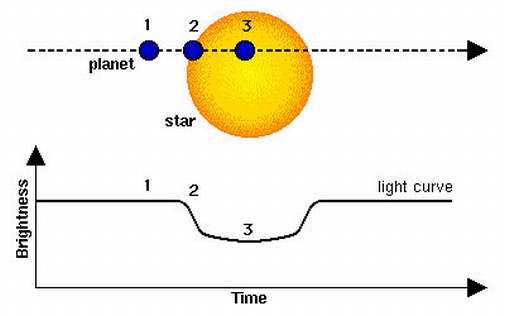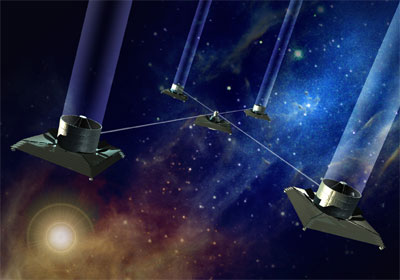|
|
Interferometry :
How to find an extrasolar planet?
Welcome to mission (almost)impossible! It is incredibly difficult to take a picture of a planet as small as Earth in orbit around a faraway star. The small planet is very faint because it only reflects the light from the star and does not emit light of its own. In addition, this faint planet appears to be so close to the much brighter star that they are almost impossible to tell apart. If we still want to find out what these alien Earths might look like we need to develop a custom telescope. One of these methods, called optical interferometry, has been identified as a key technology in NASA's search for new earths.
Basically, optical interferometry combines the light of conjoint telescopes to perform the work of a single, much larger telescope. This is possible due to the interaction of light waves, also called interference. Their interaction can be used to cancel out the blinding glare of bright stars or to measure distances and angles precisely. The word interferometry itself illustrates this idea: interfere + measure = interfer-o-metry.
 As the planet passes in front of its parent star, the brightness of the star decreases.
As the planet passes in front of its parent star, the brightness of the star decreases.
Interferometry at radio wavelengths has been employed to observe the structure of distant galaxies by their radio emissions for almost half a century. But techniques to perform interferometry at optical wavelengths, using computers and state-of-the-art light sensors, have only matured within the past 15 years.
The sections below go into more detail about the principles of optical interferometry. If you want to see how these principles are applied in the lab, try out the virtual interferometer at right.
Light and Waves
Visible light and radio waves represent different segments of the same electromagnetic spectrum. Both travel at the speed of almost 186,000 miles per second and share properties that are familiar from waves on the ocean. It is this wave nature of light that makes interferometery possible.
The two keywords to understanding interferometry are wavelength and amplitude. The wavelength of a wave is the distance between two neighboring crests of a wave. Imagine you are a surfer on the top of a crest and a friend of yours is right behind you on the next crest; then the wavelength of the wave you are riding is the distance between you and your friend. For light, different wavelength means different colors. Red light has a longer wavelength than blue light.
The second keyword is the strength, or amplitude of a wave. The amplitude is half of the height the bottom to the crest of a wave. Bright lights have larger amplitudes than dim lights.
 Infrared interferometer concept in space
Infrared interferometer concept in space
|
If two rays of light match each other perfectly in color, they can interact in a surprising way. Because all the crests of one wave have the same wavelength as the second ray the crests of the two waves can be lined up with each other. As each wave crest of one ray coincides with the crest of the other ray, the two amplitudes of the waves add up to twice the amplitude and the result is a single, much brighter light ray. This is called constructive interference. (Probably the only time when it is considered constructive to interfere!)
However, if we shift one light ray by just half a wavelength the result will be very distinctive. Now all the crests of one wave coincide with the troughs of the other wave and the two rays cancel each other out. Suddenly two rays of light add up to darkness.
Through very subtle adjustments to the two light rays we can change light into dark and light again. Astronomers can for example precise-set an interferometer to block out the light from a bright star and still collect all the light from a faint planet in orbit around this star.
| |
• back to top • disclaimer • home •
|
|

